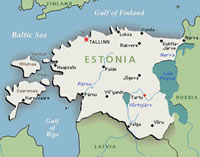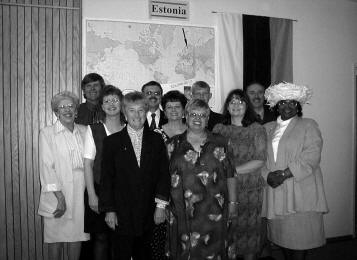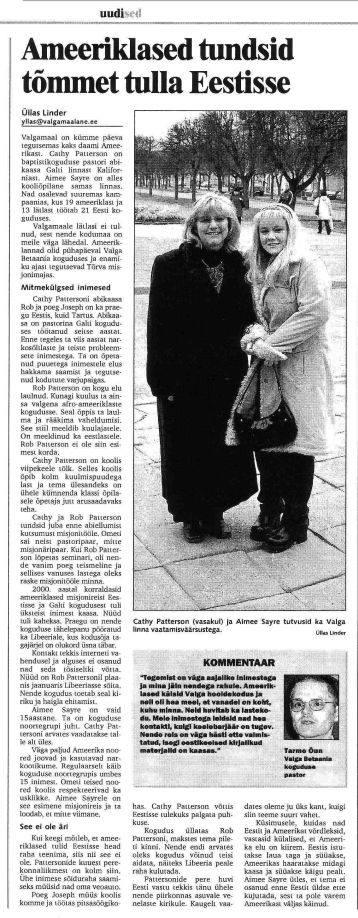|
 News
From Estonia News
From Estonia
Estonia:
Evangelistic
Cooperation and Alliance
November 1, 2004
According to the
recently-published report "Kui kristlik on
Eestimaa?" ("How Christian is Estonia?",
available in Estonian and English), Estonia, the
northernmost Baltic nation, has 1,476,031
inhabitants and only 491 Christian churches.
Even the organizers were surprised by the number
of participants: 220 people, among which were
many denominational leaders and pastors,
attended the 2nd Church Growth Conference in
Tallinn on 13th March 1997The seminar, at which
the DAWN strategy was discussed, was organized
by the Estonian Evangelical Alliance (EEA), led
by Olav Parnamets, Superintendent of the
Estonian Methodist Church and Pastor Indrek
Luide from Rapla. Figures presented by Alland
Parman and supported by the latest information
from Tiit Sepp, 2nd Chairman of the Estonian
Ministry of Religion, showed that there are
around 990 villages of over 100 inhabitants
without an evangelical church.
Over 13% of the population does not attend
church simply because they have no transport.
Church attendance in the country is stagnant or
declining. The result of the seminar was a
resolution by the attendees to cooperate in
achieving the aim of "every person in Estonia
being able to not only hear the gospel but join
a church" by opening new churches and preaching
rooms.
The Evangelical-Lutheran Church of Estonia
also joined in the resolution. Leevi Reinaru, a
pastor in the Lutheran church, reported that his
church had recently opened 10 new preaching rooms; the Methodist church plans to double
its present number of 22 churches by the end of
the century; the Union of Baptist and Free
Churches plans to expand from 85 to 100 churches
in the same period, and Harry Leesment, leader
of a Bible school in Suurupi near Tallinn,
said that "the Estonian Christian Pentecostal
Church will soon set a concrete target".
Source: Wolfgang Simson, DAWN
-
Union of
Evangelical Christian and Baptist Churches of
Estonia
The beginning of the Union of Evangelical
Christian and Baptist Churches of Estonia (union)
goes back to the Estonian national reawakening in
the 19th century, when two Swedish schoolmasters,
Thorén and Österblom, started preaching in the
island of Vormsi and the peninsula of Noarootsi,
West Estonia.
The Estonian farmers had a longing for a simple,
personal faith. There were more and more farmhouses
where people gathered to study the Bible giving rise
to the formation of independent Free Churches. The
desire to model the religious life of the Church,
and individual, on the Bible has not changed to date
among the members of the union.
In 1884 the first Estonian Baptist church was
started in Haapsalu, West Estonia. In a few decades
Baptist churches spread across the whole country.
They became known for their good sermons, lively
music, and large Sunday schools. Soon publishing
became an important aspect of their work, too. Two
years later, in 1886, the need for a distinct
fellowship was realized, and in 1900 the Baptist
churches in Estonia were finally recognized as an
independent union.
Ten years later, Evangelical Christians and
Pentecostals launched their work, too. None of the
movements had an easy start but the hardships
provided them soil for later growth.
The main activities of the union are in the
church services, teaching, preaching, and mission
work. There is plenty of common action as
co-operation enables the churches to achieve results
that would be impossible for a single church alone.
The principle of the union is to be a Biblical
missionary movement aiming at holiness and church
growth.
Missions as a challenge
The churches in the union have been active
preachers of the Gospel as long as they have been
around. When the first Baptist and Free
Churches were born the zeal of the born-again
believers made a great impact, and churches were
growing fast because of their own preaching and
testifying.
In the 1920s a number of missionaries were sent
to many different countries. The Union
churches are actively involved in the evangelistic
task. To co-ordinate and guide the work, the union
has appointed a mission secretary, who leads a
mission-minded team of workers known by the name of
the Missionary Foundation.
Since 1993 the Union has been encouraging its
church members through many different
mission-related activities. Once a year, mission
conferences are held for the whole Union; regional
mission conferences have taken place since 1998.
There is a number of traditions in the churches;
for example, evangelistic weeks or weekends in
winter, tent meetings or various evangelistic
campaigns in summer.
Youth and children's work for changed lives
During the years of the first Estonian Republic
(1918-1940), the churches of the union had a number
of efficient youth programs. When the
Communists took over, youth work could only proceed
underground. In 1988, when the atmosphere had
begun to 'thaw', youth work became public again,
large Sunday schools were born, and youth classes,
camps and clubs gained a new momentum.
In 1989 the children's magazine Päikesekiir
(Sunbeam) was published. Things improved
dramatically and the church youth workers were able
to get training, teaching materials, organized
events and information much more easily. The annual
Bible Days and the Children's Day are two most
awaited events. Most of the children who attend
Sunday school are from religion-friendly but not
religious homes.
The aim of the youth work is not merely action or
participation at various events or knowledge of the
history of religion but changed lives. The problems
facing our youth and children are complicated and
should not be overlooked by the church. This is why
the Centre for Youth and Children's Work has a
number of options for young people.
Learning is part of being a Christian
For three years the disciples walked with Jesus
and listened to his teaching. Yet later they had a
need for even greater understanding of Him and His
mission. The union's training follows the same
Biblical model. No matter how long we have been
Christians we have to go on learning what it means
to follow Christ. Bible studies in churches,
materials for independent work, and training
programs, are all designed for the purpose of
helping Christians become more Christ-like.
Where there are students there is a need for
teachers. The Union has started the Higher
Theological Seminary, whose motto is: "Hand in hand
with the churches, for the benefit of our fellow men
and for the growth of Christians!"
The aim of the Bible School courses is to prepare
Christians spiritually as well as motivate them for
practical church work and further learning.
The motto of the Bible School, "Now everyone has a
chance to study," means a choice between the
one-year intensive training ('the School of the
Twelve') and regional module-based correspondence
courses ('the School of the Seventy').
Large events as an expression of mutual
fellowship
Large organized events, expressing the unity and
the size of the Union, clearly reveal the majesty of
God. In recent years it has become a tradition
to come together for the Summer Days: for services,
concerts, and workshops. There is place and enough
to do for both young and old.
For many decades the Bible Days have offered
youth an opportunity to get to know one another and
serve God in a wonderful fellowship. It is not
common for 500 young Christians to meet together
here, but not so uncommon during the Bible Days!
The culmination of the Sunday School year is the
annual Children's Day when half a thousand kids from
our Union gather to the 'heart of Estonia' in Paide
to learn, and serve God together.
Music
Music has always enjoyed an important role in the
life of the Union churches. In 1997 a new hymnbook,
containing a rich variety of Christian hymns, was
published. Besides more traditional songs, many
churches use the so-called worship songs in their
services. The music cultivated in the churches
is varied. All the main types of choir music
are represented, but different vocal and
instrumental ensembles and small groups with a
variety of styles may be encountered, too.
|

 Yet
Estonia is experiencing a new beginning. A new
government was established in 1992, and the last
Soviet troops left two years later. Today there is a
new spirit of hope. Buildings are being restored
everywhere, many of them centuries old and left to
crumble under the Soviets. Estonians are beginning
to learn what freedom means, making strides to think
independently and truly express themselves.
Believers in Estonia have a deep desire for their
countrymen to hear about the real freedom that is
found only in Jesus Christ.
Yet
Estonia is experiencing a new beginning. A new
government was established in 1992, and the last
Soviet troops left two years later. Today there is a
new spirit of hope. Buildings are being restored
everywhere, many of them centuries old and left to
crumble under the Soviets. Estonians are beginning
to learn what freedom means, making strides to think
independently and truly express themselves.
Believers in Estonia have a deep desire for their
countrymen to hear about the real freedom that is
found only in Jesus Christ. 

 News
From Estonia
News
From Estonia